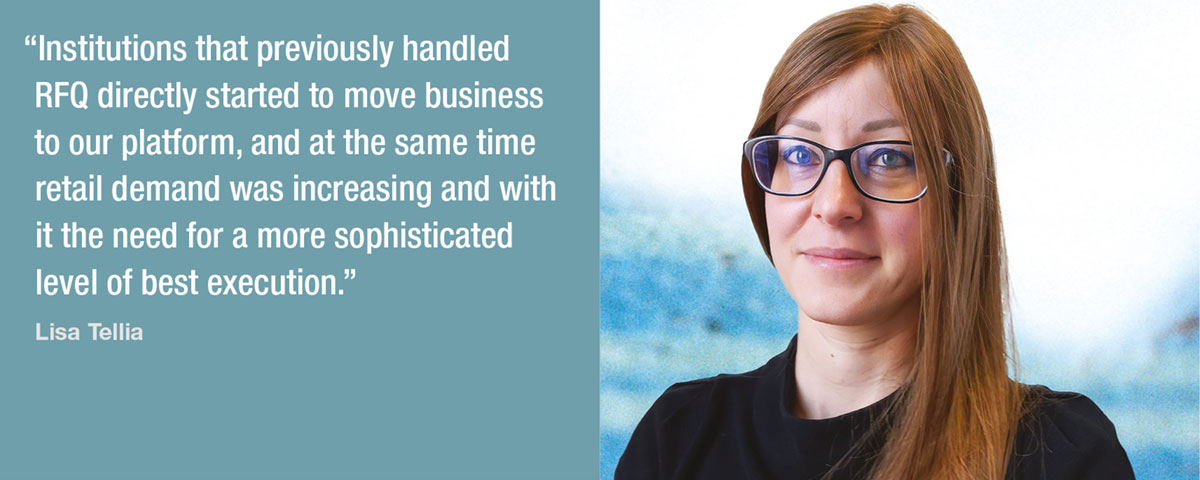By Lisa Tellia, E-Commerce Distribution – Market Hub, Global Markets Sales & Platforms at Intesa Sanpaolo
Fixed Income execution has traditionally been very complex and comparable to an ‘art’. This is due to a combination of the breadth of factors involved such as size, liquidity, credit, the number of ISINs involved and the lack of listed markets, requiring the ‘manual’ aggregation of fragmented pools of liquidity. Orders have typically been sent by large institutions and for conspicuous sizes.
The development of electronic platforms has gradually and increasingly changed this landscape with a growing percentage of trades now executed electronically: in 2021 near 80% of daily trades were executed electronically.
The 2020 Covid pandemic started to contribute to this trend, marking new record volumes in trading fixed income on electronic platforms.
As a result, we have experienced a continuous trend towards a reduction of average order sizes driven by the increased opportunity of handling these orders on platform.
In parallel, the recent increase in interest rates has boosted retail demand, which can now be served efficiently by routing orders to platforms and a wide range of available auto-execution solutions.
These trends have deeply impacted broker-agency fixed income intermediation and specifically the execution of the so called ‘retail size flow’.
The experience of Intesa Sanpaolo Market Hub, arguably one of the leading retail-size fixed income execution platforms since its launch in 2008, thanks to its key role in the Italian market, and how we rapidly evolved our business over the last 24 months, tells an interesting story of these changes and how we responded to market trends and the needs of Italian and international clients.
Italian listed markets have historically represented a unique ecosystem for private investors and provided the opportunity to compare prices coming from MOT, EuroTLX and later Hi-MTF (recently rebranded Vorvel).
As a background, for the past 15 years Intesa Sanpaolo Market Hub has been offering a best execution brokerage solution in Italy for fixed income, based on the combination of a smart order router screening the Italian listed markets, combined with access to a dedicated desk of execution specialists, called Market Hub PIT to handle larger orders or orders in less liquid instruments, which required the application of the fixed income ‘manual art’ of execution, giving access to multiple counterparties. Market Hub used a dedicated technology platform for managing these orders, closely interconnected with the bank’s main execution platform used for the listed markets.
In 2022, the platform traded more than 4,000 ISINs and by volume, executed 67% in government bonds and 33% in credit, reaching more than 65 liquidity providers with the top 20 executing 93% of flow.
Italy’s listed markets provide the opportunity of comparing prices coming from MOT, EuroTLX and Vorvel. Orders not suitable for the listed markets were executed by a specialist desk that sent RFQs to a list of market makers. This customised approach to every single order limited the possibility to expand the service to all clients’ retail orders.
Since then, a number of events have contributed to dramatically change this landscape:
- MiFID II and the establishment of MTF fixed income platforms;
- The development of trading automation solutions such as Tradeweb AiEX;
- The trend towards outsourcing and an efficient streamlining of execution desk operations;
- The Covid pandemic;
- The integration of EuroTLX into Borsa Italiana in 2020, with the removal of dual listed ISINs, which reduced competition among listed markets.
Focussing on the last two events, if we go back to Q1 2020, suddenly clients and traders had to start running their daily activity from their own homes. Disruption reduced liquidity and firms couldn’t manage their business and process their trades the way they would normally have done. These unusual working conditions during the Covid-19 pandemic raised the need to outsource flows to guarantee best execution. The need to minimise operational risks, aggravated by physical distances, led clients and brokers to massively start using fixed interconnections to trade and this boosted the need for automation. Trading by voice slowed down, substituted by electronic trading. In this situation, broker-agency desks able to provide best execution electronically saw their business increasing.
This situation, not conceivable for trading activity before March 2020, became the new standard and this set-up, which lasted longer than expected, changed the mindset of many financial operators and the ability to delegate best execution became crucial.
Whereas, prior to 2020, smaller size orders were directed electronically by clients that worked bigger in-house size orders, now institutional clients started to outsource best execution on larger sized orders too. In Intesa Sanpaolo Market Hub PIT, the desk dedicated to best execution on bonds on MTFs, we have seen an increase in the average traded size of 65%, comparing traded orders from Q2 2020 with Q2 2019, due to the increase of the flows of institutional size orders.
Institutions that previously handled RFQ directly started to move business to our platform, and at the same time retail demand was increasing and with it the need for a more sophisticated level of best execution.
The best execution process that ran in Market Hub PIT had an impressive track record on handling large orders, comparing prices coming from listed venues and market makers via MTFs, thanks to our high touch approach on every single order, but we needed to make some changes to address the increasing number of institutions requesting best execution.
At the same time market trends highlighted the urgency of reviewing our best execution model for our massive flow of smaller sized orders and to respond to the need of our other segments of institutional clients: retail banks, private banks and retail aggregators.
Furthermore, in Italy, the acquisition of EuroTLX by Borsa Italiana meant the gradual end of dual listing, and a client could no longer benefit from price competition between these two listed markets. In this situation the possibility of comparing listed market prices with prices coming from market makers on a wider perimeter of orders became crucial, while access to electronic execution on platform had become much faster. Therefore, a new model for retail size orders was mature. The challenge accelerated when Borsa Italiana formally stopped the dual listing of most of its bonds.
We made two key innovations to our execution model:
- The integration of our two execution platforms into one, which meant that routing to listed markets or to the electronic platforms was handled by the same GUI and with an integrated set of execution reports;
- We integrated Tradeweb AiEX in our execution workflow, increasing the breadth and speed of our MTF connectivity to the MTFs. We now connect to the main European D2C MTFs.
By September 2022, we had already activated our first batch of clients, and we are gradually implementing a new model, reshaping the service already provided to specific order types. The implementation of this model has been crucial in recent months, with the growth of the interest in fixed income coming from retail clients due to yields becoming more attractive.
The new model, combining both high and low touch approaches, delivers benefits in the execution of orders of all sizes. By obtaining the best possible result it increases competition among markets when executing client orders irrespective of order type.
On retail size orders the comparison of prices on both listed markets and MTFs guarantees the optimal pricing level for the client and grants economic benefits even for the smaller sizes. The speed of response in pricing from market makers in MTFs avoids the possible penalty of a better price on the listed markets, that would be hit if the MTFs prices are not competitive.
On large size orders the manual intervention allows a better execution level leveraging the operators’ experience, market knowledge, and improving liquidity search and price discovery.
Based on preliminary statistics from Market Hub’s own data, the adoption of this solution allows clients to reach on average an 11% benefit on costs for retail orders and a 26% benefit on costs for larger size orders. This benefit is more noticeable on corporate bonds compared to government bonds, which are usually more liquid.
More than ever it has been critical to understand the change in clients’ business models and to react, developing a new strategic solution to offer multiple ways to execute orders to both institutional and retail clients.
©Markets Media Europe 2023
©Markets Media Europe 2025


























